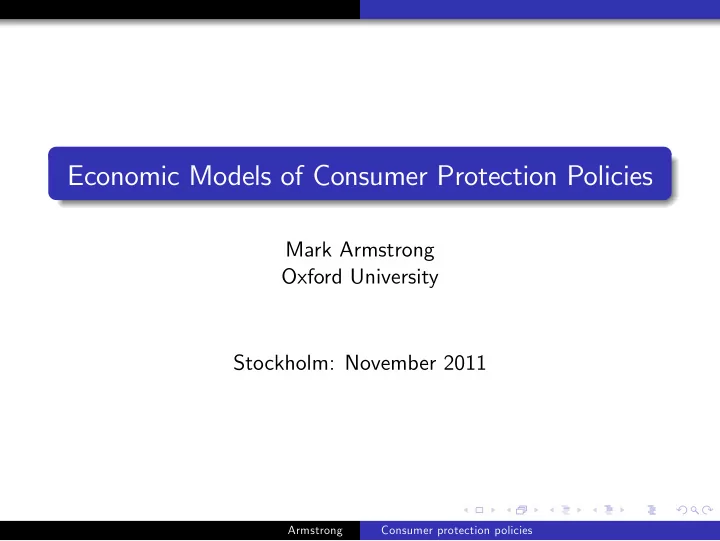

Economic Models of Consumer Protection Policies Mark Armstrong Oxford University Stockholm: November 2011 Armstrong Consumer protection policies
Introduction Historically, far more “economics” in antitrust policy than in consumer policy typically, more money at stake in antitrust much consumer policy presumes “non rational” consumer behavior big exception is focus (mostly in 1980s) on search/information problems But changing now, in part as Behavioral Economics diffuses into the discipline Here I summarise some of my recent research on the topic (with John Vickers and Jidong Zhou) mostly with “old” focus on search/information problems in markets with rational consumers Armstrong Consumer protection policies
Consumer Protection and Moral Hazard I Armstrong, Vickers & Zhou (2009), “Consumer protection and the incentive to become informed” If consumers are over-protected in the market they may take less care in their choice akin to car insurance: if drivers are fully compensated for theft, they take less care to lock their car Consider market with endogenous price dispersion where consumers choose to be either less informed or (by incurring a search cost) better informed about prices in the market latter observe more prices, and so pay lower expected price proportion who choose to be better informed depends on extent of price dispersion in market average prices chosen by firms depend on proportion of consumers who are informed Armstrong Consumer protection policies
Consumer Protection and Moral Hazard II Suppose policy imposes a cap on permitted prices the policy has pros and cons: for a fixed proportion of informed consumers, policy is pro-consumer but cap reduces price dispersion, and so reduces proportion of informed consumers Theorem: if search cost is the same for all consumers and cap is not so tight that all price dispersion eradicated, policy harms all consumers [see also Knittel & Stango, AER , 2003] moral hazard effect necessarily outweighs the direct price-reduction effect this is protection which consumers don’t need similar “perverse” effects might be seen with “Do not call” lists and other policies which facilitate refusal of advertising would be useful in future to extend analysis to focus on policy towards exploitation in the small print Armstrong Consumer protection policies
Rushed Decision Making I Armstrong & Zhou (2011), “Exploding offers and buy-now discounts” Sellers sometimes make consumers decide on-the-spot i.e., before consumers can discover alternative deals available seller needs to distinguish new visitors from those who come back to buy later (fine for doorstep sellers, home improvements etc., but not supermarkets) Consider simplified setting with a single seller surplus from buying firm’s product at price p is u − p u is idiosyncratic match value: fraction of consumers with u ≥ p is Q ( p ) if consumer does not buy seller’s product, her uncertain outside option is v ≥ 0 v might represent the deals available from rival suppliers u and v are independent Armstrong Consumer protection policies
Rushed Decision Making II crucially, she does not know v when she first visits (or is visited by) the monopolist Free recall sales policy: consumers always investigate outside option in case it’s better with price p , consumer buys if u − p ≥ v seller’s expected demand is E v [ Q ( p + v )] Exploding offer sales policy: with price p , consumer buys if u − p ≥ E v [ v ] seller’s expected demand is Q ( p + E v [ v ]) Theorem: [from Jensen’s Inequality] firm makes exploding offers if demand curve Q is concave firm allows free recall if demand curve Q is convex Result also holds without commitment if some consumers are “credulous”, and mistakenly believe salesman’s patter Armstrong Consumer protection policies
Rushed Decision Making III For given price p , use of exploding offers harms consumers typically, use of an exploding offer also involves a higher price then there is a double consumer harm: poor matching and higher price Less extreme sales tactic is to offer a “buy-now discount” e.g., seller offers 10% discount on “regular price” if consumer agrees immediately essentially this policy is always profitable (if feasible) despite its being framed as a “discount”, this tactic can induce all prices to rise Armstrong Consumer protection policies
Commission-Based Selling I Armstrong & Zhou (2011), “Paying for prominence” In markets with search frictions, a prominent product (e.g., one encountered first in a consumer’s search process) has advantage over rival products Sales intermediaries (e.g., financial advisors, magazine editors, stores) have much discretion over which products they choose to promote product suppliers may reward intermediaries on the basis of sales to encourage unobserved marketing efforts danger is that intermediary promotes product which comes with highest commission, not the best product for consumers Armstrong Consumer protection policies
Commission-Based Selling II Consider model with a single intermediary (“salesman”) which consumers must consult number of suppliers of homogeneous product each supplier chooses retail price paid by consumers and the commission it pays to salesman exogenous fraction of consumers are “savvy” and buy product with lowest price remaining consumers are “credulous” and follow salesman’s recommendation Outcome is that salesman recommends product with highest commission this is the product with highest retail price, so there is “mis-selling” suppliers compete to offer high commission, which drives up their marginal costs and so also their retail prices Armstrong Consumer protection policies
Commission-Based Selling III This is a poor outcome for consumers (and sometimes for suppliers too), relative to two natural benchmarks: No salesman is present at all, and “credulous” consumers buy 1 their product randomly (this situation is just Varian’s (1980) model of sales) No commissions are paid from suppliers, and consumers pay 2 salesman directly for advice assuming fee for advice is no higher than previous commission revenue UK current policy by Financial Services Authority essentially bans commission payments from suppliers to salesmen Armstrong Consumer protection policies
Recommend
More recommend